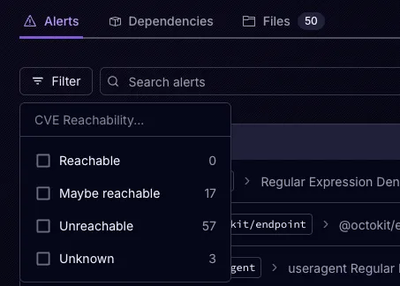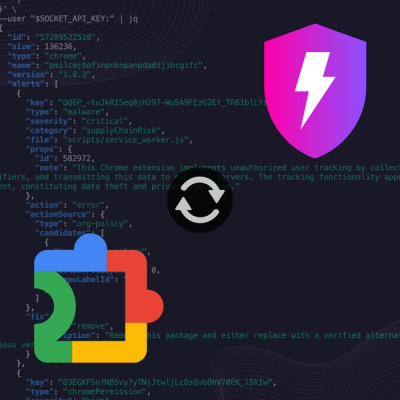
Product
Announcing Precomputed Reachability Analysis in Socket
Socket’s precomputed reachability slashes false positives by flagging up to 80% of vulnerabilities as irrelevant, with no setup and instant results.
@neodx/svg
Advanced tools
Supercharge your icons ⚡️
We're working on the new documentation, please, visit neodx.pages.dev to see the latest version.
vite, webpack, rollup, esbuild, etc.# npm
npm install -D @neodx/svg
# yarn
yarn add -D @neodx/svg
# pnpm
pnpm add -D @neodx/svg
We're highly recommended to start with our "Getting started" guide.
For better understanding and to access the latest version, please visit our documentation.
Our plugins are built upon unplugin and provide a consistent interface and working principle across all multiple bundlers and frameworks.
For instance, here's an example of vite plugin with some options:
import svg from '@neodx/svg/vite';
export default defineConfig({
plugins: [
svg({
root: 'assets',
output: 'public'
})
]
});
It will search for all SVG files in assets folder, group them by folders, optimize them with svgo,
reset all colors to currentColor and generate sprites in public folder.
For more details, see our Step-by-step guide.
Automate your icons and forget about colors management issues.
When we're working with SVG icons, we always need to control icon colors from our CSS.
Well-known approach is to use currentColor inside SVG and set color property in CSS.
However, usually, we have different issues with this approach, for example:
To solve these issues, we're providing a powerful color reset mechanism (resetColors option, enabled by default):
resetColors: false)Check out our documentation for more details.
Note: If you used
definitionsorexperimentalRuntimeoptions before, you need to update your configuration, see Migration guide.
By default, you will get the following sprites in your output:
public/
+ sprite-foo.svg
+ sprite-bar.svg
But this is not very good for caching, because if you change any of the SVG files, the sprite filename won't be updated, which could result in an infinite cache.
To solve this issue and achieve content-based hashes in filenames, you need to take three steps:
fileName option with a hash variable (e.g. fileName: "{name}.{hash:8}.svg")metadata option to get additional information about the file path by sprite name during runtimeIcon component (or whatever you use) to support the new runtime information// vite.config.ts
export default defineConfig({
plugins: [
svg({
root: 'assets',
output: 'public/sprites',
fileName: '{name}.{hash:8}.svg',
metadata: {
path: 'src/sprite.gen.ts',
runtime: {
// generate runtime metadata (path and other information) for each sprite
size: true, // will add `width` and `height` properties
viewBox: true // will add `viewBox` property
}
}
})
]
});
In the result, you will get the following sprites in your output:
/
├── assets
│ ├── common
│ │ ├── left.svg
│ │ └── right.svg
│ └── actions
│ └── close.svg
├── public
+ └── sprites
+ ├── common.12ghS6Uj.svg
+ └── actions.1A34ks78.svg
└── src
+ └── sprite.gen.ts
To learn how to use it, check out our "Writing an Icon component" guide or detailed basic tutorials:
It's a simplified tutorial, for detailed one check our "Getting started" guide.
Our example stack details:
vitereacttypescripttailwindcssWe'll be working with the following icons in our project:
/
├── assets
│ ├── common
│ │ ├── left.svg
| | ... other icons
│ │ └── right.svg
│ └── actions
│ ... other icons
│ └── close.svg
We want to generate separate sprites for each folder and use them in our React components.
import { defineConfig } from 'vite';
import svg from '@neodx/svg/vite';
import react from '@vitejs/plugin-react';
import tsconfigPaths from 'vite-tsconfig-paths';
export default defineConfig({
plugins: [
react(),
tsconfigPaths(),
svg({
root: 'assets',
group: true,
output: 'public/sprites',
metadata: 'src/shared/ui/icon/sprite.gen.ts'
})
]
});
Now let's run vite (or vite build) and see what we have:
/
├── assets
│ ├── common
│ │ ├── left.svg
│ │ └── right.svg
│ └── actions
│ └── close.svg
├── public
+ └── sprites
+ ├── common.svg
+ └── actions.svg
└── src
└── shared
└── ui
└── icon
+ └── sprite.gen.ts
Now you could visit our "Writing an Icon component" guide to learn how to use it.
definitions and experimentalRuntime options to metadata APINow metadata is stable
and covered under one metadata option.
svg({
- definitions: 'src/shared/ui/icon/sprite.gen.ts',
- experimentalRuntime: true,
+ metadata: {
+ path: 'src/shared/ui/icon/sprite.gen.ts',
+ runtime: {
+ size: true,
+ viewBox: true,
+ }
+ }
});
FAQs
Supercharge your icons ⚡️
The npm package @neodx/svg receives a total of 860 weekly downloads. As such, @neodx/svg popularity was classified as not popular.
We found that @neodx/svg demonstrated a healthy version release cadence and project activity because the last version was released less than a year ago. It has 0 open source maintainers collaborating on the project.
Did you know?

Socket for GitHub automatically highlights issues in each pull request and monitors the health of all your open source dependencies. Discover the contents of your packages and block harmful activity before you install or update your dependencies.

Product
Socket’s precomputed reachability slashes false positives by flagging up to 80% of vulnerabilities as irrelevant, with no setup and instant results.

Product
Socket is launching experimental protection for Chrome extensions, scanning for malware and risky permissions to prevent silent supply chain attacks.

Product
Add secure dependency scanning to Claude Desktop with Socket MCP, a one-click extension that keeps your coding conversations safe from malicious packages.